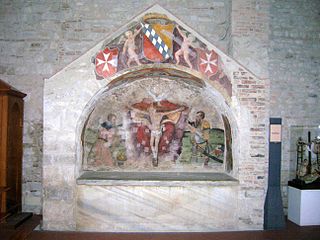
William I of Hauteville, known as William Iron Arm, was a Norman adventurer who was the founder of the fortunes of the Hauteville family. One of twelve sons of Tancred of Hauteville, he journeyed to the Mezzogiorno with his younger brother Drogo in the first half of the eleventh century (c.1035), in response to requests for help made by fellow Normans under Rainulf Drengot, count of Aversa.

Guaimar IV was Prince of Salerno (1027–1052), Duke of Amalfi (1039–1052), Duke of Gaeta (1040–1041), and Prince of Capua (1038–1047) in Southern Italy over the period from 1027 to 1052. He was an important figure in the final phase of Byzantine authority in the Mezzogiorno and the commencement of Norman power. He was, according to Amatus of Montecassino, "more courageous than his father, more generous and more courteous; indeed he possessed all the qualities a layman should have—except that he took an excessive delight in women."
Rainulf Drengot was a Norman adventurer and mercenary in southern Italy. In 1030 he became the first count of Aversa. He was a member of the Drengot family.

Pandulf IV was the Prince of Capua on three separate occasions.
Guaimar III was the Lombard prince of Salerno from around 994 to his death. Under his reign, Salerno entered an era of great splendour. Opulenta Salernum was the inscription on his coins. He made Amalfi, Gaeta and Sorrento his vassals and annexed much of Byzantine Apulia and Calabria.
Asclettin Drengot was the son of Asclettin, count of Acerenza, brother of Rainulf Drengot, whom he succeeded in the county of Aversa in 1045. He was duly elected by the Norman nobles of Aversa and invested with the countship by his suzerain, Guaimar IV of Salerno.
Richard Drengot was the count of Aversa (1049–1078), prince of Capua and duke of Gaeta (1064–1078).
Ranulf II was the count of Alife and Caiazzo, and duke of Apulia. He was a member of the Italo-Norman Drengot family which dominated the Principality of Capua for most of the century between 1050 and 1150. Ranulf's wife, Matilda, was the sister of King Roger II of Sicily.
Asclettin or Asketil was the first count of Acerenza, one of the twelve leaders of the Norman mercenaries of Guaimar IV of Salerno who conquered much of Apulia between 1038 and 1042. In the latter year, the division of the conquests twelvefold was made and Asclettin received his portion.
Osmond Drengot was one of the first Norman adventurers in the Mezzogiorno. He was the son of a petty, but rich, lord of Carreaux, at Bosc-Hyons in the region of Rouen. Carreaux gives his family the alternate name of de Quarrel.
Gilbert Buatère was one of the first Norman adventurers in the Mezzogiorno. He was the eldest son of a petty, but rich, lord of Carreaux, near Avesnes-en-Bray in the region of Rouen. Carreaux gives his family, the Drengot, the alternate name of de Quarrel.

The House of Hauteville was a Norman family originally of seigneurial rank from the Cotentin. The Hautevilles rose to prominence through their part in the Norman conquest of southern Italy. By 1130, one of their members, Roger II, was made the first King of Sicily. His male-line descendants ruled Sicily until 1194. Some Italian Hautevilles took part in the First Crusade and the founding of the Principality of Antioch (1098).
Rudolph Drengot was one of the Drengot family of Norman adventureres who came to Southern Italy with his brothers, Gilbert, Asclettin, Osmond, and Ranulf.

The Principality of Capua was a Lombard state centred on Capua in Southern Italy. Towards the end of the 10th century the Principality reached its apogee, occupying most of the Terra di Lavoro area. It was originally a gastaldate, then a county, within the principality of Salerno.
Atenulf I was the Lombard count of Aquino who rose to become Duke of Gaeta in Southern Italy during the chaotic middle of the eleventh century.
Maria of Gaeta was an Italian regent, countess of Aquino by marriage and regent of the Duchy of Gaeta for her son in 1062–65.

The Norman conquest of southern Italy lasted from 999 to 1194, involving many battles and independent conquerors.

The County of Apulia and Calabria, later the Duchy of Apulia and Calabria, was a Norman state founded by William of Hauteville in 1043 composed of the territories of Gargano, Capitanata, Apulia, Vulture, and most of Campania. It became a duchy when Robert Guiscard was raised to the rank of duke by Pope Nicholas II in 1059.
Ranulf I was the count of Caiazzo in the Principality of Capua from about 1078. He also brought the formerly Lombard counties of Alife, Telese and Sant'Agata dei Goti and the castles of Airola and Tocco Caudio under his control, dominating the region between Capua and Benevento. He passed this territorial lordship on intact to his heirs, and it remained in their possession until the death of his grandson and namesake, Ranulf II, in 1139.